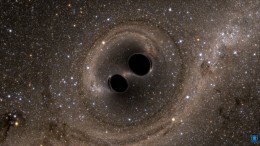Editor’s note: In these last two weeks of 2019, we’ll be looking at a few selections that we haven’t yet discussed on AAS Nova from among the most-downloaded papers published in AAS journals this year. The usual posting schedule will resume in January.
Indication of Another Intermediate-mass Black Hole in the Galactic Center
Published January 2019
Main takeaway:
By analyzing the internal motions of a cloud of molecular gas using the Atacama Large Millimeter/submillimeter Array (ALMA), a team of scientists led by Shunya Takekawa (Nobeyama Radio Observatory, NAOJ, Japan) has found evidence for a 30,000 solar-mass black hole drifting near our galaxy’s center.
Why it’s interesting:

Simulated image of two merging black holes. One theory predicts that supermassive black holes grow from the mergers of IMBH seeds. [SXS Lensing]
Why this discovery may lead to others:
The discovery of this black hole is interesting for another reason: it was found despite the fact that it’s extremely faint. Theory predicts that there are perhaps a hundred million black holes in the Milky Way. Since the vast majority of these objects are dark, however, we’ve found very few of them — only a few dozen exceptions that are bright due to active accretion. Takekawa and collaborators found the faint intermediate-mass black hole not by looking for its emission, but by examining the motions of a gas cloud around it: the gas streams of the cloud were being flung in unexpected directions due to the gravitational forces of an unseen source. By using this same technique in the future, we may be able to discover additional otherwise-invisible black holes.
Citation
Shunya Takekawa et al 2019 ApJL 871 L1. doi:10.3847/2041-8213/aafb07
